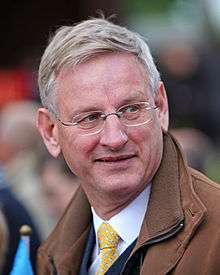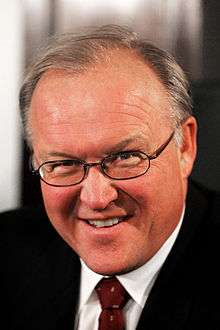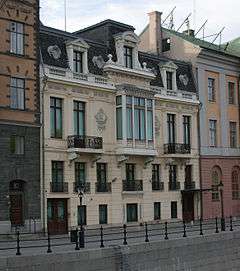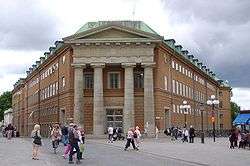Prime Minister of Sweden
| Prime Minister of Sweden
Sveriges statsminister | |
|---|---|
|
| |
|
State flag | |
| Style |
Excellency was used up to the 1970s in Sweden; but is still used in diplomatic writing[1] |
| Member of |
The Government European Council |
| Reports to | The Riksdag |
| Residence | Sager House |
| Seat | Rosenbad, Stockholm, Sweden |
| Nominator |
The Speaker of the Riksdag following consultations with the party leaders in the Riksdag |
| Appointer |
The Speaker of the Riksdag following a vote in the Riksdag |
| Term length |
No term limit serves as long as the incumbent has majority support in the Riksdag |
| Constituting instrument | 1974 Instrument of Government |
| Inaugural holder | Louis Gerhard De Geer |
| Formation | 20 March 1876 |
| Deputy | Deputy to the Prime Minister |
| Salary |
annual: 1,920,000 SEK[2] €207,478 / $229,968 / £147,239 (1 July 2015 – 30 June 2016) |
| Website | www.sweden.gov.se |
 |
| This article is part of a series on the politics and government of Sweden |
|
| Foreign relations |
|
Related topics |
The Prime Minister (Swedish: statsminister, literally "Minister of the State") is the head of government in Sweden. Before the creation of the office of a Prime Minister in 1876, Sweden did not have a head of government separate from its head of state, namely the King, in whom the executive authority was vested. Louis Gerhard De Geer, the architect behind the new bicameral Riksdag of 1866 that replaced the centuries-old Riksdag of the Estates, became the first officeholder in 1876.
The current Prime Minister of Sweden is Stefan Löfven, leader of the Swedish Social Democratic Party.[3]
History
Before 1876, when the office of a single prime minister was created, Sweden did not have a head of government separate from the King. Historically though, the most senior member of the Privy Council (during the absolute rule this was the Lord High Chancellor) had certain similarities to the office of a head of government. This was most evident during the so-called Age of Liberty from 1718 to 1772, when powers of the Monarch were greatly reduced and the President of the Privy Council became the most powerful political figure in Sweden.
At the adoption of the new Instrument of Government of 1809, the two offices of Prime Minister for Justice (Swedish: Justitiestatsminister) and Prime Minister for Foreign Affairs (Swedish: Utrikesstatsminister) were created, though their roles were no more than just the heads of their respective ministries. When the office of the Prime Minister was created in 1876, the Prime Ministers for Justice and Foreign Affairs were thus subsequently demoted to Minister for Justice and Minister for Foreign Affairs. Unlike the Minister for Justice, the Minister for Foreign Affairs did however continue to be styled as "Excellency", an honour shared only with the Prime Minister.[4][5] From 1917, parliamentarian principles were definitively established in Sweden and the Monarch ceased to exercise his constitutional authority to appoint the Prime Minister and the Councillors of State (cabinet ministers) at his own discretion. From that time onward, the Prime Minister depended on the support of a majority in the Riksdag. Over time, the Prime Minister came to de facto exercise the Royal prerogatives. However, the Swedish term used for the Government during this period, still was Kungl. Maj:t, an abbreviation of Kunglig Majestät (English: Royal Majesty).
Until 1974, the executive authority in Sweden had been exercised through the King in Council. Constitutional reform provided a new Instrument of Government which de jure established the parliamentary system and created a cabinet government with constitutional powers not derived from the Crown.
List of Prime Ministers
Living former Prime Ministers
- Living former Prime Ministers
-
Ola Ullsten
born 23 June 1931
served 1978–1979 -

Ingvar Carlsson
born 9 November 1934
served 1986–1991 and 1994–1996 -

Carl Bildt
born 15 July 1949
served 1991–1994 -

Göran Persson
born 20 January 1949
served 1996–2006 -

Fredrik Reinfeldt
born 4 August 1965
served 2006–2014
Duties
Whenever a Prime Minister resigns, dies, or is forced from office by the Riksdag, the Speaker of the Riksdag asks him (or his deputy) to keep the government as a caretaker government until a successor has been elected. The Speaker then holds consultations with the party leaders and appoints a Prime Minister-designate, who is submitted for approval to the Riksdag. If the Prime Minister-designate is approved he or she chooses which and how many members (ministers) are to be included in his or her government.[6]
With the exception of the Prime Minister, cabinet ministers (Swedish: statsråd) do not need the approval of the Riksdag, but they can be forced to resign by a vote of no confidence. If the Prime Minister is forced by a vote of no confidence to resign, the entire cabinet falls, and the process of electing a Prime minister starts over. The Prime Minister can dissolve the Riksdag, even after receiving a vote of no confidence, except during the first three months after an election.
The Instrument of Government requires that the Prime Minister appoint a member of the cabinet as Deputy Prime Minister, to perform the duties of the Prime Minister in the event that he or she cannot. However, if a Deputy Prime Minister is absent or has not been appointed, the senior minister in the cabinet becomes acting head of government. If more than one minister has equal tenure, the eldest assumes the position (see Swedish governmental line of succession for the present governmental line of succession).
On paper, the Prime Minister's position is stronger than that of his counterparts in Denmark and Norway. This is because the Swedish prime minister is a constitutional office with duties specifically enumerated in the Instrument of Government, and is both de jure and de facto chief executive. In the two neighboring Scandinavian monarchies, the monarch is the nominal chief executive, but is bound by convention to act on the advice of the ministers. However, the so-called Torekov Compromise reached in 1971 by the major political parties, codified with Instrument of Government that went into effect in 1975, stripped the Swedish monarch of even a nominal role in governmental affairs, thus codifying actual practices that had been in place since the definitive establishment of parliamentary government in 1917.
Amenities
Office and residences
The government offices, including the Prime Minister's office, is located at Rosenbad in central Stockholm, straight across the water from Helgeandsholmen with the Riksdag building.
In 1991 the Sager House (or the "Sager Palace" as it was previously called) was acquired, and since 1995 it has served as the private residence of the Prime Minister. The Sager House is located adjacent to Rosenbad and the parliament building.
Harpsund, a manor house in Flen Municipality, Södermanland County, has served as a country residence for the Prime Minister since 1953. The manor is also frequently used for governmental conferences and informal summits between the government, industry and organisations in Sweden.
Salary
The salaries of the cabinet ministers, including the Prime Minister, is decided by and is the subject of annual review by the Statsrådsarvodesnämnden ("Cabinet Ministers' Salary Committee") of the Riksdag. Since 1 July 2015 the Prime Minister's monthly salary is 160,000 SEK (€17,290 / $19,164 / £12,270) or 1,920,000 SEK (€207,478 / $229,968 / £147,239) per year.[2]
Gallery
-

The Rosenbad building has functioned as the Prime Minister's Office (Statsrådsberedningen) since 1981.
-

The Sager Palace is the Prime Minister's official residence.
-
Harpsund Manor has been used as the Prime Minister's country residence since 1953.
-

Kanslihuset was where the Prime Minister's Office was located prior to 1981. Nowadays it houses offices of the Riksdag.
See also
- Air transports of heads of state and government
- Deputy Prime Minister of Sweden
- Elections in Sweden
- Official state car
- Swedish governmental line of succession
- List of living Prime Ministers of Sweden
- List of Prime Ministers of Sweden
- List of cabinets of Sweden
- List of Swedish politicians
- List of Spouses of the Prime Ministers of Sweden
References
- ↑ , Protocol and Liaison Service, United Nations.
- 1 2 "Statsrådsarvoden och ersättningar (Swedish)". Regeringen.se.
- ↑ http://uk.reuters.com/article/2014/10/02/uk-sweden-pm-idUKKCN0HR1AX20141002
- ↑ Sveriges statskalender 1915, runeberg.org. Retrieved on 12 June 2013.(Swedish)
- ↑ Sveriges statskalender 1964, runeberg.org. Retrieved on 12 June 2013.(Swedish)
- ↑ "How a Government is formed". Government Offices of Sweden. 2006-08-02. Retrieved 2008-01-05.
- Bibliography
- The Instrument of Government (PDF). Stockholm: The Riksdag. 2012.
- The Riksdag Act (PDF). Stockholm: The Riksdag. 2012.
- Larsson, Torbjörn; Bäck, Henry (2008). Governing and Governance in Sweden. Lund: Studentlitteratur AB. ISBN 978-91-44-03682-3.
- Petersson, Olof (2010). Den offentliga makten (in Swedish). Stockholm: SNS Förlag. ISBN 978-91-86203-66-5.
External links
- Prime Minister's Office, official website

.jpg)